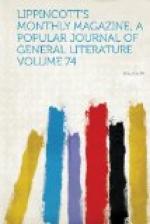FOOTNOTES
LIST OF ILLUSTRATIONS.
Temple of the Clitumnus.
The falls of terni.
Orvieto.
CIVITA Bagnorea.
The Tiber, from Orte.
Borghetto.
St. Peter’s and
the Vatican, from the falls
of the Tiber.
The castle of st.
Angelo.
Island of the Tiber.
Cupola of st. Peter’s.
The PINCIO, from the
villa Borghese.
Soracte.
Veii, from the Campagna.
Tivoli.
Castle at ostia.
Head of the trajan
canal, near ostia.
FOLLOWING THE TIBER.
Concluding paper.
[Illustration: Temple of the Clitumnus.]
One branch of the little river which encompasses Assisi is the Clitumnus, the delight of philosophers and poets in the Augustan age. Near its source stands a beautiful little temple to the divinity of the stream. Although the ancients resorted hither for the loveliness of the spot, they did not bathe in the springs, a gentle superstition holding it sacrilege for the human body to lave itself in a stream near its source.
[Illustration: The falls of terni.]
They came by the Via Flaminia, the old high-road from Rome to Florence, which crosses the modern railroad hard by. Following its course, which takes a more direct line than the devious Tiber, past Spoleto on its woody castellated height, the traveler reaches Terni on the tumultuous Nar, the wildest and most rebellious of all the tributaries. It was to save the surrounding country from its outbreaks that the channel was made by the Romans B.C. 271, the first of several experiments which resulted in these cascades, which have been more sung and oftener painted than any other in the world. The beauty of Terni is so hackneyed that enthusiasm over it becomes cockney, yet the beauty of hackneyed things is as eternal as the verity of truisms, and no more loses its charm than the other its point. But one must not talk about it. The foaming torrent rages along between its rocky walls until spanned by the bridge of Augustus at Narni, a magnificent viaduct sixty feet high, thrown from ridge to ridge across the ravine for the passage of the Flaminian Way—a wreck now, for two of the arches have fallen, but through the last there is a glimpse of the rugged hillsides with their thick forests and the turbulent waters rushing through the chasm. Higher still is Narni, looking over her embattled walls. It is one of the most striking positions on the way from Florence to Rome, and the next half hour, through savage gorges and black tunnels, ever beside the tormented waters of the Nar until they meet the Tiber, swollen by the tributes of the Paglia and Chiana, is singularly fine.




